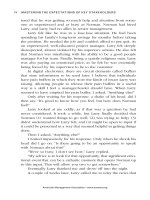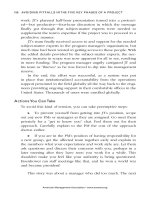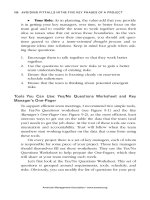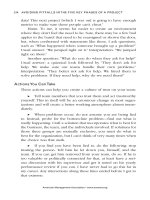gobel - graduation debt; how to manage student loans and live your life (2010)
Bạn đang xem bản rút gọn của tài liệu. Xem và tải ngay bản đầy đủ của tài liệu tại đây (12.41 MB, 241 trang )
Visit us online @ CliffsNotes.com
®
“Gobel writes in a straightforward, matter-of-fact way that makes it easy for the reader to
understand the nuances of student debt without feeling overwhelmed. This book is full of
relevant information that is organized perfectly for someone who wants a quick but thorough
understanding of how to repay student debt in an effi cient yet manageable way.”
—Erin Joyce, Managing Editor, Investopedia; President and Owner, E3 Writing Services
der t
o
full of
oroug
h
Services
Reyna Gobel, M.B.A., M.J.
• Evaluate Your Student Debt Situation
• Consolidate Your Federal Loans
• Manage Your Private Loans
and Payoff Strategies
• Pay Off Your Non-Student-Loan Debt
Graduation
Debt
Graduation Debt
How to Manage Student
Loans and Live Your Life
How to Manage Student Loans
and Live Your Life
Gobel
$14.99 US/$17.99 CAN
9780470506899_RB3.PDF
Get a plan to manage student loan debt!
Are you up to your eyeballs in student loan debt? You aren’t alone! This trusted
guide gives you a step-by-step road map for getting out from under student loan
debt while keeping the rest of your fi nances on track. You’ll get expert advice
on how to:
• Evaluate your student debt situation
• Organize your student debt payments
• Consolidate your federal loans
• Manage your private loans and payoff strategies
• Budget for your lifestyle and your loans
• Pay off your non-student-loan debt
• Understand how your debt looks to lenders
• Budget during infl ation, layoffs, pay cuts, and career changes
• Pay off your student loans early
Reyna Gobel, M.B.A., M.J., is a freelance journalist who specializes in
fi nancial fi tness. Her fi nancial advice appears regularly on www.investopedia.com
and Yahoo! Finance, as well as other print and online outlets.
506899_cover.indd 1506899_cover.indd 1 2/3/10 2:18 PM2/3/10 2:18 PM
01_506899-ffirs.indd ii01_506899-ffirs.indd ii 2/16/10 10:03 PM2/16/10 10:03 PM
Graduation
Debt
01_506899-ffirs.indd i01_506899-ffirs.indd i 2/16/10 10:03 PM2/16/10 10:03 PM
01_506899-ffirs.indd ii01_506899-ffirs.indd ii 2/16/10 10:03 PM2/16/10 10:03 PM
How to Manage Student Loans
and Live Your Life
by Reyna Gobel
Graduation
Debt
01_506899-ffirs.indd iii01_506899-ffirs.indd iii 2/16/10 10:03 PM2/16/10 10:03 PM
CliffsNotes
®
Graduation Debt: How to Manage Student Loans and Live Your Life
Copyright © 2010 by Reyna Gobel. All rights reserved.
Published by Wiley Publishing, Inc., Hoboken, New Jersey
No part of this publication may be reproduced, stored in a retrieval system or transmitted in any
form or by any means, electronic, mechanical, photocopying, recording, scanning or otherwise,
except as permitted under Sections 107 or 108 of the 1976 United States Copyright Act, without
either the prior written permission of the Publisher, or authorization through payment of the
appropriate per-copy fee to the Copyright Clearance Center, 222 Rosewood Drive, Danvers, MA
01923, (978) 750-8400, fax (978) 646-8600, or on the web at www.copyright.com. Requests to the
Publisher for permission should be addressed to the Permissions Department, John Wiley & Sons,
Inc., 111 River Street, Hoboken, NJ 07030, (201) 748-6011, fax (201) 748-6008, or online at http://
www.wiley.com/go/permissions.
Wiley, the Wiley Publishing logo, and related trademarks are trademarks or registered trademarks
of John Wiley & Sons, Inc. and/or its affiliates. All other trademarks are the property of their
respective owners. Wiley Publishing, Inc. is not associated with any product or vendor mentioned
in this book.
The publisher and the author make no representations or warranties with respect to the accuracy
or completeness of the contents of this work and specifically disclaim all warranties, including
without limitation warranties of fitness for a particular purpose. No warranty may be created or
extended by sales or promotional materials. The advice and strategies contained herein may not
be suitable for every situation. This work is sold with the understanding that the publisher is not
engaged in rendering legal, accounting, or other professional services. If professional assistance is
required, the services of a competent professional person should be sought. Neither the publisher
nor the author shall be liable for damages arising here from. The fact that an organization or Web-
site is referred to in this work as a citation and/or a potential source of further information does
not mean that the author or the publisher endorses the information the organization or Website
may provide or recommendations it may make. Further, readers should be aware that Internet
Websites listed in this work may have changed or disappeared between when this work was writ-
ten and when it is read.
For general information on our other products and services or to obtain technical support please
contact our Customer Care Department within the U.S. at (877) 762-2974, outside the U.S. at
(317) 572-3993 or fax (317) 572-4002.
Wiley also publishes its books in a variety of electronic formats. Some content that appears in
print may not be available in electronic books. For more information about Wiley products, please
visit our web site at www.wiley.com.
Library of Congress Cataloging-in-Publication Data:
Gobel, Reyna, 1977-
Graduation debt : how to manage student loans and live your life / by Reyna Gobel.
p. cm.
ISBN-13: 978-0-470-50689-9
ISBN-10: 0-470-50689-X
1. Student loans. 2. Education, Higher Finance. I. Title.
LB2340.G63 2010
378.3’62 dc22
2010002930
Printed in the United States of America
10 9 8 7 6 5 4 3 2 1
Book production by Wiley Publishing, Inc., Composition Services
01_506899-ffirs.indd iv01_506899-ffirs.indd iv 2/16/10 10:03 PM2/16/10 10:03 PM
Peggy Engel, Dr. James Conover,
Grace Freedson, and Jeff Inman; my
family; and my Miniature Schnauzer,
Mauser. Without any of these
people—or my dog sitting behind
my office chair to keep me from
getting up while writing—this book
wouldn’t have happened.
01_506899-ffirs.indd v01_506899-ffirs.indd v 2/16/10 10:03 PM2/16/10 10:03 PM
01_506899-ffirs.indd vi01_506899-ffirs.indd vi 2/16/10 10:03 PM2/16/10 10:03 PM
vii
Acknowledgments
Thank you:
Peggy Engel, my mentor, for believing a book on repaying student
loans needed to be written, and that I was the one who should write it.
Grace Freedson, my literary agent, for sticking by a first-time book
author through fruition.
Greg Tubach and the rest of the gang at Wiley for giving me the
honor of writing under the CliffsNotes brand. Adrienne Fontaine and
Malati Chavali, for helping me get the word out that this book exists.
And, of course, my editor, Lynn Northrup, who kept my writing on track
when I started to go off on tangents.
My interviewees, who agreed to talk conversationally about their
subject of expertise: Tom Harnisch, Barry Paperno, Robbi Ernst III, Mar-
tha Holler, Patricia Christel, Debby Hohler, Jim Southwell, Bob Mei-
ghan, Teri Gault, Chelsea Marti, Tony Bambacino, and Dr. James
Conover.
My real-life interviewees, who trusted me enough to share their debt
stories: Dawn, Melissa, and Kristen and Erik.
All the editors who let a former and still occasional entertainment
and pop culture writer near the subject of personal finance, especially
Glenn Rosen, Carin Hughes, Tara Struyk, Erin Joyce, and Lisa Ocker.
My mom and dad, who taught me to find a way to help others, and
to do math problems without a calculator.
My husband, who supports me in everything that I do, including tell-
ing a few stories from our relationship in this book.
My journalism professors, who tolerated me in class and taught me
a thing or two: George Getschow, Dan Malone, Katherine Jones, Dr.
Land, Dr. Koehler, and Dr. Lambiase. Stephanie Babyak and Jane Glick-
man, for their invaluable research help on student loan regulations.
My first writing mentor, Jeff Inman, who was the first person who
taught me how to write well.
Finally, I’d like to thank my co-worker, my Miniature Schnauzer,
Mauser, who sat behind my chair every day while I wrote this book—
except when barking at whoever dared to walk by our home or at me
when he craved attention, a treat, a walk, or a car ride.
01_506899-ffirs.indd vii01_506899-ffirs.indd vii 2/16/10 10:03 PM2/16/10 10:03 PM
01_506899-ffirs.indd viii01_506899-ffirs.indd viii 2/16/10 10:03 PM2/16/10 10:03 PM
ix
Table of Contents
About the Author . . . . . . . . . . . . . . . . . . . . . . . . . . . . . . . . xiii
Introduction . . . . . . . . . . . . . . . . . . . . . . . . . . . . . . . . . . . . .xv
1
Evaluating Your Student Debt Situation . . . . . . . . . . . . . . . 1
Facing Your Student Debt Demons. . . . . . . . . . . . . . . . . . . . . . . . . 1
The National Student Loan Data System (NSLDS) . . . . . . . . . . . . . 2
Making Sense of Your Individual Charts . . . . . . . . . . . . . . . . . . . . 9
Constructing Your Personal Student Loan Chart . . . . . . . . . . . . . 14
Double Listings, Inaccurate Listings, and No Listings . . . . . . . . 16
Chapter Wrap-Up . . . . . . . . . . . . . . . . . . . . . . . . . . . . . . . . . . . . . . 19
2
Organizing Your Student Debt Payments . . . . . . . . . . . . . 21
Default Rehab. . . . . . . . . . . . . . . . . . . . . . . . . . . . . . . . . . . . . . . . . 21
Affording Your Payments. . . . . . . . . . . . . . . . . . . . . . . . . . . . . . . . 25
Deferments and Forbearance . . . . . . . . . . . . . . . . . . . . . . . . . . . . 27
Implications of Missing a Student Loan Payment . . . . . . . . . . . . 29
Loan Forgiveness. . . . . . . . . . . . . . . . . . . . . . . . . . . . . . . . . . . . . . 31
Adjusting Withholding. . . . . . . . . . . . . . . . . . . . . . . . . . . . . . . . . . 36
Income-Based Repayment Plans . . . . . . . . . . . . . . . . . . . . . . . . . 39
Returning to School . . . . . . . . . . . . . . . . . . . . . . . . . . . . . . . . . . . . 41
Chapter Wrap-Up . . . . . . . . . . . . . . . . . . . . . . . . . . . . . . . . . . . . . . 43
3
Consolidating Your Federal Loans . . . . . . . . . . . . . . . . . . .45
What Is Consolidation? . . . . . . . . . . . . . . . . . . . . . . . . . . . . . . . . . 46
Should You Consolidate Your Loans?. . . . . . . . . . . . . . . . . . . . . . 46
The Coveted Fixed Interest Rate . . . . . . . . . . . . . . . . . . . . . . . . . . 47
More Benefits to Consolidating . . . . . . . . . . . . . . . . . . . . . . . . . . 51
How to Consolidate Your Loans . . . . . . . . . . . . . . . . . . . . . . . . . . 52
Benefits Before October 2007. . . . . . . . . . . . . . . . . . . . . . . . . . . . 53
Deferment and Forbearance Options with Consolidation. . . . . . 56
What if Your Loan Is Sold to Another Bank?. . . . . . . . . . . . . . . . . 58
Stray Loans After Consolidation . . . . . . . . . . . . . . . . . . . . . . . . . . 60
Reconsolidating . . . . . . . . . . . . . . . . . . . . . . . . . . . . . . . . . . . . . . . 60
Chapter Wrap-Up . . . . . . . . . . . . . . . . . . . . . . . . . . . . . . . . . . . . . . 62
02_506899-ftoc.indd ix02_506899-ftoc.indd ix 2/16/10 10:06 PM2/16/10 10:06 PM
x
4
Managing Your Private Loans and Payoff Strategies . . . .63
Federal Loans vs. Private Loans . . . . . . . . . . . . . . . . . . . . . . . . . . 63
Gathering Information on Your Private Loans . . . . . . . . . . . . . . . 64
Private Loans Chart . . . . . . . . . . . . . . . . . . . . . . . . . . . . . . . . . . . . 65
Interest Rate Terms . . . . . . . . . . . . . . . . . . . . . . . . . . . . . . . . . . . . 66
Length of Repayment. . . . . . . . . . . . . . . . . . . . . . . . . . . . . . . . . . . 73
Financial Hardship. . . . . . . . . . . . . . . . . . . . . . . . . . . . . . . . . . . . . 74
Options for Paying Off or Transferring Private Loan Debt. . . . . . 75
Case Study: Repaying $300,000 in Student Loan Debt . . . . . . . 80
The Debt-to-Income Ratio for Private Loan Debt . . . . . . . . . . . . . 82
Chapter Wrap-Up . . . . . . . . . . . . . . . . . . . . . . . . . . . . . . . . . . . . . . 85
5
Budgeting for Your Lifestyle and Your Loans . . . . . . . . . .87
Budgeting Starts Today. . . . . . . . . . . . . . . . . . . . . . . . . . . . . . . . . 87
Create a Financial Diary. . . . . . . . . . . . . . . . . . . . . . . . . . . . . . . . . 89
Getting the Best Rate . . . . . . . . . . . . . . . . . . . . . . . . . . . . . . . . . . . 94
Saving on Groceries. . . . . . . . . . . . . . . . . . . . . . . . . . . . . . . . . . . . 95
Prioritizing and Choosing Budgetary Cutbacks. . . . . . . . . . . . . 100
Negotiating Interest Rates on Debt. . . . . . . . . . . . . . . . . . . . . . . 103
Checking Account Safety Nets. . . . . . . . . . . . . . . . . . . . . . . . . . . 103
Budgeting for Your Personal Must-Haves . . . . . . . . . . . . . . . . . 107
Chapter Wrap-Up . . . . . . . . . . . . . . . . . . . . . . . . . . . . . . . . . . . . . 108
6
Paying Off Your Non-Student-Loan Debt . . . . . . . . . . . . .109
Ordering Free Credit Reports . . . . . . . . . . . . . . . . . . . . . . . . . . . 109
Reviewing Your Entire Debt Portfolio . . . . . . . . . . . . . . . . . . . . . 110
Larger Education Equals Smaller Car. . . . . . . . . . . . . . . . . . . . . 112
Your First College Credit Cards . . . . . . . . . . . . . . . . . . . . . . . . . . 114
Chapter Wrap-Up . . . . . . . . . . . . . . . . . . . . . . . . . . . . . . . . . . . . . 120
7
Understanding How Your Debt Looks to Lenders . . . . . .123
FICO Credit Scores . . . . . . . . . . . . . . . . . . . . . . . . . . . . . . . . . . . . 123
What Different Scores Mean . . . . . . . . . . . . . . . . . . . . . . . . . . . . 130
Disputing Mistakes on Your Credit Reports . . . . . . . . . . . . . . . . 130
Bad Credit Cards Build Good Credit . . . . . . . . . . . . . . . . . . . . . . 132
Debt-to-Income Ratio. . . . . . . . . . . . . . . . . . . . . . . . . . . . . . . . . . 133
Chapter Wrap-Up . . . . . . . . . . . . . . . . . . . . . . . . . . . . . . . . . . . . . 135
02_506899-ftoc.indd x02_506899-ftoc.indd x 2/16/10 10:06 PM2/16/10 10:06 PM
xi
8
Surviving Debt and Relationships . . . . . . . . . . . . . . . . . . 137
Debt Meets Relationship . . . . . . . . . . . . . . . . . . . . . . . . . . . . . . . 137
Combining Credit. . . . . . . . . . . . . . . . . . . . . . . . . . . . . . . . . . . . . 139
The One-Income Household . . . . . . . . . . . . . . . . . . . . . . . . . . . . 144
Case Study: A Life in Student Loans . . . . . . . . . . . . . . . . . . . . . . 146
Chapter Wrap-Up . . . . . . . . . . . . . . . . . . . . . . . . . . . . . . . . . . . . . 147
9
Budgeting During Inflation . . . . . . . . . . . . . . . . . . . . . . . .149
Saving on Your Electricity Bill . . . . . . . . . . . . . . . . . . . . . . . . . . . 149
Energy Audits. . . . . . . . . . . . . . . . . . . . . . . . . . . . . . . . . . . . . . . . 153
Fuel-Saving Tips. . . . . . . . . . . . . . . . . . . . . . . . . . . . . . . . . . . . . . 154
Car Maintenance Schedules . . . . . . . . . . . . . . . . . . . . . . . . . . . . 155
Saving Money on Commuting. . . . . . . . . . . . . . . . . . . . . . . . . . . 157
Moving Closer to Work. . . . . . . . . . . . . . . . . . . . . . . . . . . . . . . . . 158
Chapter Wrap-Up . . . . . . . . . . . . . . . . . . . . . . . . . . . . . . . . . . . . . 160
10
Budgeting Through Layoffs, Pay Cuts, and
Career Changes . . . . . . . . . . . . . . . . . . . . . . . . . . . . . . . . . 161
Jolt Your Savings . . . . . . . . . . . . . . . . . . . . . . . . . . . . . . . . . . . . . 161
Preventing Long-Term Damage from a Layoff . . . . . . . . . . . . . . 164
The Bare-Bones Budget. . . . . . . . . . . . . . . . . . . . . . . . . . . . . . . . 166
Use Loan Forbearance Sparingly . . . . . . . . . . . . . . . . . . . . . . . . 167
Paying Down Credit Card and Loan Balances . . . . . . . . . . . . . . 168
Involuntary Unemployment Credit Card Insurance . . . . . . . . . . 170
Chapter Wrap-Up . . . . . . . . . . . . . . . . . . . . . . . . . . . . . . . . . . . . . 172
11
Paying Off Your Student Loans Early . . . . . . . . . . . . . . . . 175
Adding Money to Your Loan Payments. . . . . . . . . . . . . . . . . . . . 175
Biweekly Loan Payments . . . . . . . . . . . . . . . . . . . . . . . . . . . . . . . 177
Direct Debit Interest Rate Deductions. . . . . . . . . . . . . . . . . . . . . 178
Student Loan Interest Tax Deduction . . . . . . . . . . . . . . . . . . . . . 180
Workplace Bonuses and Salary Increases . . . . . . . . . . . . . . . . . 184
Free Cash Rebate Programs . . . . . . . . . . . . . . . . . . . . . . . . . . . . 185
Credit Card Rewards . . . . . . . . . . . . . . . . . . . . . . . . . . . . . . . . . . 187
Government Programs . . . . . . . . . . . . . . . . . . . . . . . . . . . . . . . . 188
Using Online Calculators. . . . . . . . . . . . . . . . . . . . . . . . . . . . . . . 188
Chapter Wrap-Up . . . . . . . . . . . . . . . . . . . . . . . . . . . . . . . . . . . . . 190
02_506899-ftoc.indd xi02_506899-ftoc.indd xi 2/16/10 10:06 PM2/16/10 10:06 PM
xii
12
Reaping the Rewards of a Frugal Lifestyle. . . . . . . . . . . . 191
How to Budget for Fun Extras . . . . . . . . . . . . . . . . . . . . . . . . . . . 191
Fun-Account Strategies . . . . . . . . . . . . . . . . . . . . . . . . . . . . . . . . 192
Stretching Your Fun Account Further . . . . . . . . . . . . . . . . . . . . . 194
Eating Out. . . . . . . . . . . . . . . . . . . . . . . . . . . . . . . . . . . . . . . . . . . 195
Saving on Vacations . . . . . . . . . . . . . . . . . . . . . . . . . . . . . . . . . . 198
You’ve Earned a New Car. . . . . . . . . . . . . . . . . . . . . . . . . . . . . . . 202
Moving into a Nicer Place . . . . . . . . . . . . . . . . . . . . . . . . . . . . . . 203
Feeling Financially Secure. . . . . . . . . . . . . . . . . . . . . . . . . . . . . . 204
Chapter Wrap-Up . . . . . . . . . . . . . . . . . . . . . . . . . . . . . . . . . . . . . 205
Index . . . . . . . . . . . . . . . . . . . . . . . . . . . . . . . . . . . . . . . . . 208
02_506899-ftoc.indd xii02_506899-ftoc.indd xii 2/16/10 10:06 PM2/16/10 10:06 PM
xiii
About the Author
Reyna Gobel, M.B.A. and M.J., is a freelance journalist who
specializes in fi nancial fi tness. Her fi nancial advice appears
regularly on www.investopedia.com and Yahoo!Finance, as
well as other print and online outlets.
03_506899-flast.indd xiii03_506899-flast.indd xiii 2/16/10 10:07 PM2/16/10 10:07 PM
03_506899-flast.indd xiv03_506899-flast.indd xiv 2/16/10 10:07 PM2/16/10 10:07 PM
xv
Introduction
When you first started college, student loans may have seemed like a
gift to help you get through school. However, your gift was borrowed
money. I knew my student loans were borrowed money, but I never
thought about how I was going to pay them back. I just assumed that
when I got a grown-up job, the money I made would easily allow me to
make the payments every month without affecting my lifestyle in any
way. The debt crept up on me, one semester’s worth of loans at a time.
Some semesters my loans totaled around $1,000; other semesters I
totaled over $7,000 of borrowed money. After a bachelor’s degree and
two master’s degrees, I racked up $63,000 in student loan debt. Even
though it was consolidated at a low 4 percent interest rate, it will still
take 30 years to pay off, at $310 a month.
Those of us with mountains of student loan debt are not alone.
Based on data from the National Center for Education Statistics, there
are over one million graduates who have at least $40,000 in student
loan debt in the United States alone.
If everyone in this predicament who has 25- and 30-year loan terms
waited until these debts were paid off to start families, save for retire-
ment, or move out of their first apartments, no one would ever leave
their matchbox-sized apartment or get married!
But most of us are not going to wait until middle age to start living
our lives, nor should we. Since we are going to have our student debt
around for up to 30 years, we need to learn to manage our payments
as another bill we have to pay, similar to an electric bill or a rent pay-
ment. You can manage your student debt while maintaining a lifestyle
that is productive in the grand scheme of a financially secure future.
By the end of this book, you will learn how to find loans for semesters
you have long forgotten, and devise a plan to make payments and even-
tually pay off your educational loans. You’ll learn when and how to use
options for postponing your loans when you have temporary financial
difficulties, such as a layoff or reduced or no pay during maternity leave.
You will also learn how to discuss debt with your significant other,
manage your other debts, keep your head above water during periods
03_506899-flast.indd xv03_506899-flast.indd xv 2/16/10 10:07 PM2/16/10 10:07 PM
xvi
of inflation and recession, rebuild your credit rating, and still enjoy
most of your guilty pleasures while you reform your budget.
I can’t promise that you will have your student debt paid off by the
time you finish reading this book—unless you happen to take ten years
to read it. But, by the end of this book, you will have a plan in place that
will help you deal with your student debt and manage your financial life
without feeling like your debt will be a hindrance to anything you want
to accomplish.
03_506899-flast.indd xvi03_506899-flast.indd xvi 2/16/10 10:07 PM2/16/10 10:07 PM
1
1
Evaluating Your Student
Debt Situation
If you pay your student loan bills every month, and then try to forget
the giant pile of debt to which your loans are attached—stop! In order
to work toward paying off your student loan debt, you need to be
aware of the existence and the amounts of each loan.
You no longer should think about whether you borrowed too much,
or if you should have rejected the part of your student loan you used
for spring break. Your new focus is on making small changes to pay off
your loans faster without impacting your life. The first step on this path
is looking up the specifics of all your federal loans in the National Stu-
dent Loan Data System.
Facing Your Student Debt Demons
Where do you begin when it comes to dealing with your debt? Figure
out what your starting point is by taking the following pop quiz to find
out how much you really know about your student loans. If you don’t
know some of the answers, don’t worry. This quiz comes with instruc-
tions for creating a kind of “cheat sheet” for getting the details on
your loans.
1.
How many different federal student loans do you have? _____
(Y
ou could have two or more per semester you were in school,
and don’t forget loans for graduate school or for any community
college or summer courses at other universities.)
2.
Are they all consolidated into one loan? ___ yes ___ no
3.
How many are subsidized? _____
04_506899-ch01.indd 104_506899-ch01.indd 1 2/16/10 10:07 PM2/16/10 10:07 PM
Graduation Debt: How to Manage Student Loans and Live Your Life
2
4.
How many are unsubsidized? _____
5.
Who are the servicers on each student loan? (Use an additional
sheet of paper if you have more servicers than can fit in the spaces
provided.)
_________________________________________________________
_________________________________________________________
_________________________________________________________
_________________________________________________________
_________________________________________________________
_________________________________________________________
_________________________________________________________
_________________________________________________________
6.
Do you have the contact information in a file? ___ yes ___ no
7.
Do you know where the file is? ___ yes ___ no
8.
Do you know your interest rates on every single loan?
___ yes ___ no
9.
If you put one loan in forbearance or deferment—temporary hold
on making payments—did you remember to hold others?
___ yes ___ no
How did you do? If you didn’t know all the answers, you are not
alone. Whether you just graduated from college or you’ve been out of
school for a decade, it’s not always easy to keep tabs on eight semes-
ters of loans—or more if you went to grad school or took five or six years
to graduate—when each could be with a separate servicer. Luckily, the
federal government offers a free Web site (www.nslds.ed.gov) where
you can locate all of your federal loans, what servicer they are with, and
the details of how much you owe. By accessing this information you can
build a kind of cheat sheet to help keep track of your loans.
The National Student Loan Data
System (NSLDS)
With the information in the National Student Loan Data System, you
can find out your interest rates and get copies of your loan contracts
04_506899-ch01.indd 204_506899-ch01.indd 2 2/16/10 10:07 PM2/16/10 10:07 PM
Evaluating Your Student Debt Situation
3
by calling and requesting the necessary information from your current
servicers with the phone numbers provided within your financial aid
review.
Using the National Student Loan Data System Web site will involve
taking the following steps.
FIND YOUR PIN
The National Student Loan Data System requires a PIN (personal iden-
tification number) to access your federal student loan information. You
have a PIN to access your student loan information for the same reason
you have one to access your bank or credit card information. You have
an account with the federal government and/or accounts with the lend-
ers backed by the federal government. What’s contained in the Student
Loan Data System is a large part of your student loan information.
If you received aid since the beginning of electronic financial aid
applications, you created a PIN for retrieving your FAFSA (Free Appli-
cation for Student Aid) that was your first step in getting federal loans
to attend college.
The best way to get started on finding your loan information is get-
ting or recovering your PIN at the PIN Web site: />PINWebApp/appinstr.jsp. If you’ve used your PIN in the last 18 months
to check on your student loans and you still remember it, you have all
the information you need to log in to the National Student Loan Data
System. You can jump to the next section of this chapter.
If you don’t remember your PIN and you have used it in the last 18
months, you have to go to the PIN Web site: www.pin.ed.gov, which
you can use to generate a PIN or retrieve your PIN. You will have to
answer a question based on information you provided on your FAFSA
for security. For example, if you selected “What is your mother’s
maiden name?” as your challenge question when you received your
PIN, you would need to provide your mother’s maiden name in order
to get a duplicate PIN.
If you don’t have one, you can create a 4-digit PIN at https://pin.
ed.gov/PINWebApp/appinstr.jsp. You will need to provide your Social
Security number, full name, address, e-mail address, and security ques-
tion (a question about yourself for security purposes). Select a question
that you can always answer and spell the same, such as your mother’s
maiden name, the name of your elementary school, or the name of the
hospital you were born in. But you still want to be careful about capi-
talization and abbreviations. The PIN Web site is case sensitive. Also,
don’t fill in an answer that you sometimes abbreviate. For example, if
your challenge question is “What is the name of your high school?”
04_506899-ch01.indd 304_506899-ch01.indd 3 2/16/10 10:07 PM2/16/10 10:07 PM
Graduation Debt: How to Manage Student Loans and Live Your Life
4
and you attended Century High School, you won’t be able to access
your account if you type in CHS.
Name changes will not affect your PIN for all of your previous loans.
Your PIN is attached to the name you had when you borrowed the
money. However, if you return to college, you need to create a new PIN
under your new legal name.
Checklist for Finding Your Student Loan PIN
✓ Remember that your student loan PIN is the same PIN you used
when you filled out your FAFSA when applying for student aid.
Now, it is the number that identifies you for retrieving all your
federal student loan information.
✓ If you don’t have your PIN, you can request a new one at the PIN
Web site: www.pin.ed.gov.
✓ Use the last name you had when you were in college with your PIN.
✓ You will need to request a new PIN if you haven’t used your PIN
for applying for student loans or retrieving your student loan
information in the last 18 months.
ACCESS THE NATIONAL STUDENT LOAN DATA
SYSTEM WEB SITE
Now that you have your PIN, you can sign in to the National Student
Loan Data System Web site at www.nslds.ed.gov. Brace yourself,
because you are going to see how much interest has accrued since the
first day you borrowed your first student loan dollar. How high could
that number be? Let’s say you borrowed $3,400 in the spring semester
of 2004 with an average interest rate of 5 percent. If you haven’t paid a
nickel on that loan by January 2010, you will have accrued $1,156 in
interest, bringing your total owed to $4,556.
From the NSLDS home page, click on Financial Aid Review. Accept
the terms and enter your Social Security number, the first two letters of
your last name during college, your date of birth, and your PIN. The first
page you will see is a chart displaying a list of your loans with Type of
Loan, Loan Amount, Loan Date, Disbursed Amount, Canceled Amount,
Outstanding Principal, and Outstanding Interest. What do all these
terms mean and how is this chart going to help you manage your loans?
The chart on the student loan data system Web site will give you all
the information you need to find your student loans and information
04_506899-ch01.indd 404_506899-ch01.indd 4 2/16/10 10:07 PM2/16/10 10:07 PM
Evaluating Your Student Debt Situation
5
about them. However, if the chart just looks like a bunch of gibberish
with the dozens of terms you need to know, you won’t get much out of
it. So let’s look first at an explanation of the terms that will be most
important in deciphering the information you need.
Types of Loans
The federal government categorizes your loans in several different
ways:
• Consolidated: This is a com-
bined loan from multiple
semesters. For example, if
you consolidated loans after
you finished your undergrad-
uate degree, you could have
eight semesters of loans in
one consolidation loan.
• Subsidized: With a subsi-
dized loan, the government
pays your interest while you
attend college and other spe-
cial circumstances.
• Unsubsidized: With an unsub-
sidized loan, you pay your own
interest in all circumstances.
• FFEL (Federal Family Education Loan) Program: These loans
are with a servicer other than the government but they are feder-
ally backed loans and qualify for most of the same repayment
programs as direct loans. They can also be consolidated to direct
lending.
• Direct: This kind of loan is issued directly from the government
via direct lending as a servicer.
• Stafford: The most common type of federal loan, it can come in
many forms, such as consolidated or unconsolidated or subsi-
dized or unsubsidized. It can be serviced by either direct lending
or another servicer.
• Perkins: This category of student loans is fairly rare and is nor-
mally reserved for low-income families. If you have these, you may
have additional options for loan forgiveness.
Caution
If you consolidated your
loans after graduation, it
doesn’t mean all of your
loans were consolidated. If
you forget to name a loan to
your servicer, it may have
fallen by the wayside. When
you construct your Personal
Student Loan chart at the end
of this chapter look at the
balances owed on all your
loans, whether or not you
believe it was consolidated.
04_506899-ch01.indd 504_506899-ch01.indd 5 2/16/10 10:07 PM2/16/10 10:07 PM
Graduation Debt: How to Manage Student Loans and Live Your Life
6
Loans Chart Categories
Not sure what all the terms mean on your Loans chart? Use the follow-
ing term list as a guideline for the categories you’ll see:
• Loan Amount: The amount you were approved to borrow for a
specific semester. This amount may not have the amount you
received. For instance, let’s say you were approved for $6,000, but
you decided you only needed $3,500. The other $2,500 you were
approved for you don’t have to pay back because you never bor-
rowed this money.
• Loan Date: This is the date you originally took out your loan. It is
helpful in deciphering in which semester you borrowed that par-
ticular amount of money. Be aware that you could have more than
one loan per semester. For instance, let’s say the government
gave you x amount of money in a certain semester in a subsidized
loan where your interest is paid while you attend college. Then
you were given an additional loan to cover the rest of your
expenses in the form of an unsubsidized loan.
• Disbursed Amount: This is the original amount of money you
borrowed on the specified loan date. It has nothing to do with
how much you owe now, because interest has accrued and pay-
ments have been made. For example, in the fall semester of 2003,
you borrowed a student loan in the amount of $3,500. After seven
years of an average interest rate of 5 percent, you now owe $4,924
(figuring in compounded interest).
• Canceled Amount: If you see a canceled amount on your Loans
chart, it means that amount is no longer owed. It could be for a
variety of reasons: Perhaps you became disabled and could no
longer make payments, you completed a loan forgiveness pro-
gram, or you rejected part of the financial aid package you were
rewarded. For example, I applied for financial aid in my last
semester of school. However, I looked at the debt I’d already
accumulated and decided I didn’t want to have $70,000 worth of
student loan debt. So I arranged a payment plan with my univer-
sity to pay over the course of the semester instead of taking on
new debt. For that particular semester, a cancelled amount is
shown on my Loans chart for the loans I turned down.
• Outstanding Principal: This is the amount of your original loan
that you still owe. However, outstanding interest is added to this
amount to create your total balance. For example, let’s say you
04_506899-ch01.indd 604_506899-ch01.indd 6 2/16/10 10:07 PM2/16/10 10:07 PM
Evaluating Your Student Debt Situation
7
consolidated all your loans into one 30-year loan of $60,000 in
2007. You’ve been making payments for two years and have an
interest rate of 5 percent. You now owe $58,184. This reflects
$1,816 you’ve paid toward your principal, but it doesn’t have any-
thing to do with the $5,915 you’ve already spent in interest.
• Enrollment Status: Your enrollment status dictates whether you
are a part-time student, full-time student, graduate student, or
have graduated. For example: part time, full time, graduated.
Although your enrollment status won’t affect anything in the Stu-
dent Loan chart you will create at the end of this chapter, it could
affect consolidation if you are still in school (see Chapter 3, “Con-
solidating Your Federal Loans”). Generally, you will wait until after
graduation to consolidate your loans.
• Outstanding Interest: The outstanding interest is the interest
accrued since your last student loan payment. This could be what
has accrued during a period of temporary payment reprieve or
since your last monthly
payment,
• Repayment: When you start
sending in your loans, you’ll
start to hear the term repay-
ment constantly. This just
means that you are repaying
your loan company for the
payments you received when
you were in college.
Checklist for Understanding Student Loan Terms
✓ Print your charts from the National Student Loan Data System.
✓ Go through the information in your charts and make a list of the
terms you don’t know.
✓ Look up those terms in the Types of Loans and Loans Chart Cat-
egories lists in this chapter.
✓ Refer to the lists if you have questions as you get further into
organizing your debt.
FIND ALL OF YOUR STUDENT LOANS
When you look at your first chart on the opening page of your file on the
National Student Loan Data System Web site, you see information that
Caution
Don’t get thrown off if the aid
summary shows your new
name at the top. You still log
in under your former legal
name if you are using your
original PIN number.
04_506899-ch01.indd 704_506899-ch01.indd 7 2/16/10 10:07 PM2/16/10 10:07 PM









